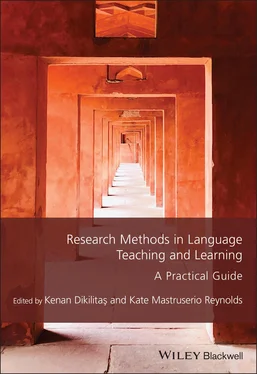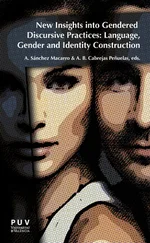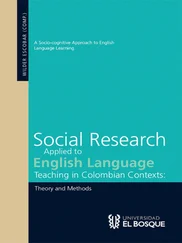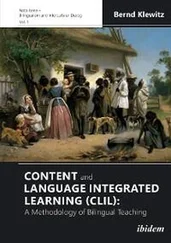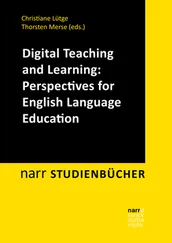Research Methods in Language Teaching and Learning
Здесь есть возможность читать онлайн «Research Methods in Language Teaching and Learning» — ознакомительный отрывок электронной книги совершенно бесплатно, а после прочтения отрывка купить полную версию. В некоторых случаях можно слушать аудио, скачать через торрент в формате fb2 и присутствует краткое содержание. Жанр: unrecognised, на английском языке. Описание произведения, (предисловие) а так же отзывы посетителей доступны на портале библиотеки ЛибКат.
- Название:Research Methods in Language Teaching and Learning
- Автор:
- Жанр:
- Год:неизвестен
- ISBN:нет данных
- Рейтинг книги:5 / 5. Голосов: 1
-
Избранное:Добавить в избранное
- Отзывы:
-
Ваша оценка:
- 100
- 1
- 2
- 3
- 4
- 5
Research Methods in Language Teaching and Learning: краткое содержание, описание и аннотация
Предлагаем к чтению аннотацию, описание, краткое содержание или предисловие (зависит от того, что написал сам автор книги «Research Methods in Language Teaching and Learning»). Если вы не нашли необходимую информацию о книге — напишите в комментариях, мы постараемся отыскать её.
Research Methods in Language Teaching and Learning
Research Methods in Language Teaching and Learning
Research Methods in Language Teaching and Learning — читать онлайн ознакомительный отрывок
Ниже представлен текст книги, разбитый по страницам. Система сохранения места последней прочитанной страницы, позволяет с удобством читать онлайн бесплатно книгу «Research Methods in Language Teaching and Learning», без необходимости каждый раз заново искать на чём Вы остановились. Поставьте закладку, и сможете в любой момент перейти на страницу, на которой закончили чтение.
Интервал:
Закладка:
It also seemed possible that the actual act of reflecting on and recording experiences through a diary may have caused participant “reactance” (Bolger et al., 2003), that is, changed their behavior, experience, or ways of thinking. For Bolger et al. (ibid.), the overall impact of reactance on the validity of diary data is likely to be relatively limited as initial changes in behavior fade over time, with diarists becoming increasingly used to their role as research participants through a process of “habituation.” That said, many learners in my diary study experienced changes in the way they experienced and perceived group work, while, for some, the act of reflecting brought the unconscious into consciousness, and/or led to the development of more complex understandings of classroom life (see also, Hall, 2008, pp. 116–117), echoing Elliott’s (1997) report of participants’ diary entries becoming more reflective over the course of her study.
Consequently, when analyzing the diary data, I had to some extent to “distrust” it. This involved the recognition that the data was partial; it was at times contradictory and recorded participants’ many and multiple “truths”; it included elements that were irrelevant to the study’s aims; and some diarists’ voices appeared within it more strongly than others’. Yet in the context of an ethnographic study, this variation within and between data was not a weakness – similar data does not necessarily equate to reliability when dealing with participants’ insider understandings of their own experiences (see also Mackrill, 2008). All research, even that claiming to be “scientific,” is “context bound and speak[s] to certain people, times and circumstances” (Plummer, 1983, p. 14).
Thus, what was important for my study, as with all projects, was that the processes of data analysis and interpretation were transparent, that is, that I was clear about the reasons for the decisions I made about data collection and analysis, and their implications (as outlined in this chapter). Furthermore, it was also important to make this explicit when the findings of the project were disseminated through presentation and publication. Indeed, the key paper resulting from this project, Hall (2008), focuses only on such methodological issues.
Concluding Comments
Language teaching and learning is such a broad field that the possibilities for research and researchers are seemingly endless, both in terms of what might be focused on (for example, from corrective feedback to learner identity, and from testing and assessment to teacher beliefs), and what research methodology might be adopted (for example, qualitative or quantitative, longitudinal or cross-sectional). Yet publications in our field typically (and quite reasonably) focus on the findings and (sometimes) implications of research to a far greater extent than they address the methodological processes and decisions researchers engage in. In many papers, while some reference is made to the limitations of a study, the detailed decisions and even compromises that researchers make in order to be able to proceed in as rigorous a way as possible are generally omitted (not least for reasons of word count in a journal article or book chapter!). This chapter therefore sets out to address this gap, documenting in detail the reasons why I set out to undertake a particular research investigation, the principles that underpinned my broad approach to the project, the subsequent methodological possibilities which presented themselves, and, consequently, the decisions taken to pursue the investigation in practice.
The initial impetus for the project emerged first from my own classroom experiences and the puzzles I was encountering when I reflected on the degree of unpredictability in my own classes. Reading relevant literature in the field provided a coherent conceptual framework for my questions, focusing my thinking on language classrooms as complex and, at times, messy and confusing social environments, each with their own social norms of behavior and acceptable actions and reactions. From here, it was a short step to wishing to find out how this conception might play out in practice, by investigating how a particular classroom was “socially constructed.”
The subsequent decision to pursue an ethnographic methodology thus derived from the goal of seeking to understand a classroom from the teacher’s and learners’ own perspectives, and allowing that understanding to emerge from the context and the study’s participants over time. In other words, the goals and related methodologies of ethnographic research were most in keeping with my conception of the socially constructed classroom, and with my aim to explore how the teacher and learners perceived and ascribed significance to particular events.
However, putting the principles of ethnography into practice was, and is, challenging. My decision to develop ethnographic diaries offered both methodological and theoretical flexibility – the diaries could be used alongside other research tools, such as interviews, to provide deeper understanding of the classroom through the systematic and transparent analysis and interpretation of the resultant data. Yet the decisions made when planning and implementing the ethnographic diary research carried significant implications for the data and, ultimately, the findings of the project. Even though at 4 weeks long, the project was not particularly long in terms of ethnographic approaches, it required significant participant commitment, and both the design of the project and the diaries and the way in which this was communicated and developed with participants was central to the resultant data, both in terms of its quantity and quality. Meanwhile, the participants contributed to the project with differing degrees of openness, reflectivity, and/or forgetfulness. Subsequent data analysis and interpretation thus needed to recognize the central role of myself as the researcher and the research methodology, making this transparent when disseminating the findings (Hall, 2008).
Despite these challenges, however, this ethnographic diary study offered a way of undertaking research that was truly participatory. It provided participants with a more evident sense of control within the research process, and was a “space” for teachers and learners to reveal their own perspectives on their classroom. In spite of the demands on their time and energy, the participants potentially benefited from engaging in the study and reflecting upon their own actions and contexts, becoming, to some extent, co-researchers in the research project. Thus, although the use of diaries in general, and ethnographic diaries in particular, is currently relatively rare within language teaching and learning research, more studies, particularly those that document transparently the ways in which the researcher “is the primary research instrument,” would be a valuable addition to our understanding of the complex and socially constructed nature of language classrooms.
Questions
If you were to design ethnographic diaries in order to research a particular context and group of learners and/or teachers with which you are familiar, what would the key features of the diaries be, and why? For example, to what extent would the diary be structured or unstructured? How often would you ask participants to update their diary? Would the diary follow a “traditional” paper-and-pen format or make use of new technologies?
In what ways do you think your decisions and actions as a researcher might affect the data? How would you deal with these issues during the process of data analysis and interpretation?
Note
1 1Although diary-based research into language teaching and learning can be traced back to the early 1980s (e.g., Bailey, 1981 study of an individual’s language learning experience, and her 1983 examination of competitiveness and anxiety among adult learners; Brown’s, 1985 exploration of the differences between adult and young learners), more recent diary studies remain relatively uncommon. Published studies include Yi’s (2008) investigation into teachers’ perceptions and use of rating schemes, Lopera Medina’s (2013) study of the teaching of reading, and Farrell’s (2013) account of teachers’ own professional development through diary-writing. Meanwhile, learners’ experiences and concerns have occasionally been uncovered through diary approaches, including fluctuations in the motivation of an individual learner (Casanave, 2012), the language anxiety experienced by students in a specific class (Gkonou, 2012), and more general difficulties and constraints on learning English experienced by students within an institution (Huang, 2005).
Читать дальшеИнтервал:
Закладка:
Похожие книги на «Research Methods in Language Teaching and Learning»
Представляем Вашему вниманию похожие книги на «Research Methods in Language Teaching and Learning» списком для выбора. Мы отобрали схожую по названию и смыслу литературу в надежде предоставить читателям больше вариантов отыскать новые, интересные, ещё непрочитанные произведения.
Обсуждение, отзывы о книге «Research Methods in Language Teaching and Learning» и просто собственные мнения читателей. Оставьте ваши комментарии, напишите, что Вы думаете о произведении, его смысле или главных героях. Укажите что конкретно понравилось, а что нет, и почему Вы так считаете.
